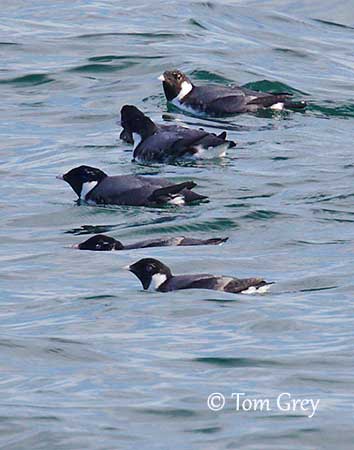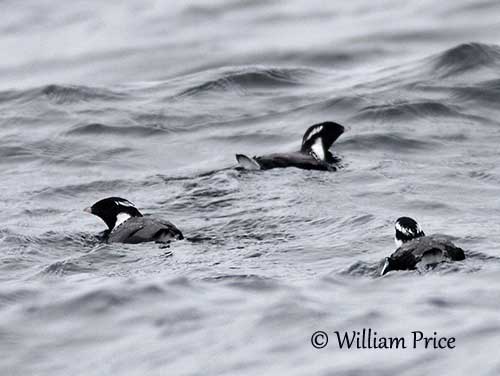
Fr: Guillemot à cou blanc
Ang: Ancient Murrelet
All: Silberalk
Esp: Mérgulo Antiguo
Ita: Urietta canuta
Nd: Zilveralk
Sd: Kragalka
Photographers:
Tom Grey
Tom Grey's Bird Pictures & Tom Grey's Bird Pictures 2
Ken Havard
My Bird Gallery & Flickr gallery 1 & Flickr gallery 2
William Price
PBase-tereksandpiper & Flickr William Price
Text by Nicole Bouglouan
Sources:
HANDBOOK OF THE BIRDS OF THE WORLD Vol 3 by Josep del Hoyo-Andrew Elliott-Jordi Sargatal - Lynx Edicions - ISBN : 8487334202
THE HANDBOOK OF BIRD IDENTIFICATION FOR EUROPE AND THE WESTERN PALEARCTIC by Mark Beaman, Steve Madge - C. Helm - ISBN: 0713639601
L’ENCYCLOPEDIE MONDIALE DES OISEAUX - Dr Christopher M. Perrins - BORDAS - ISBN: 2040185607
All About Birds (Cornell Lab of Ornithology)
Bird Web (Seattle Audubon Society)
What Bird-The ultimate Bird Guide (Mitchell Waite)
Wikipedia, the free encyclopaedia
Alaska Seabird Information Series
Ancient Murrelet (Synthliboramphus antiquus)
ANCIENT MURRELET - Original prepared by Anne Harfenist
Ancient Murrelet
Synthliboramphus antiquus
Charadriiformes Order – Alcidae Family
INTRODUCTION:
The Ancient Murrelet is closely related to the Japanese Murrelet, and both species are very similar.
The Ancient Murrelet is abundant and widespread. It breeds in N Pacific and Bering Strait, and reaches Japan and California outside the breeding season.
It nests on islands where introduced predators cause some decline. It usually frequents cool waters, and flocks can be seen over the edge of the continental shelf. But they may come close to the shores where tidal currents drive abundant food near the surface.
Like numerous Alcidae, the Ancient Murrelet is colonial and nests in burrows on densely vegetated islands.

DESCRIPTION OF THE BIRD:
Biometrics:
Length: 24-27 cm
Weight: 177-250 g
The Ancient Murrelet is a small, stocky Alcid. It has slate-grey upperparts and white underparts with dark grey on body sides, forming a dark separation between belly and underwing.
Head, nape and throat are black. The white of the underparts extends around the black throat to the head sides. There is a white stripe made with filamentous plumes (filoplumes) over eye to nape.
The short bill is horn-coloured with dark culmen. The eyes are dark brown. Legs and webbed feet are pinkish-grey with blackish webs.
During winter, the adult lacks the white filoplumes, the throat is less black and on the underparts, the white extends up to the neck sides.
Male and female are similar.
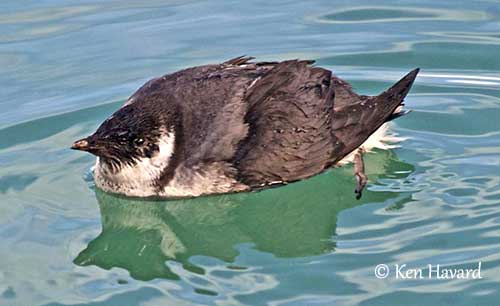
The juvenile resembles adult in winter but it is duller and browner. It has shorter and darker bill, and the black of the head extends down only to the gape, whereas chin and lower face are white with dark wash.
SUBSPECIES AND RANGE:
The Ancient Murrelet has two recognized subspecies.
S.a. antiquus (described above) is found in Yellow Sea and Sea of Japan, N through Sakhalin, Kuril Islands and N of Sea of Okhotsk to Kamchatka, and E through Aleutians to S Alaska, and then S to British Columbia (Queen Charlotte Islands).+
S.a. microrynchos is found in Commander Islands. It winters offshore on the continental shelf off Japan and Korea, S to Taiwan, and off W America S to California.
This race has smaller bill and less speckles on neck sides.
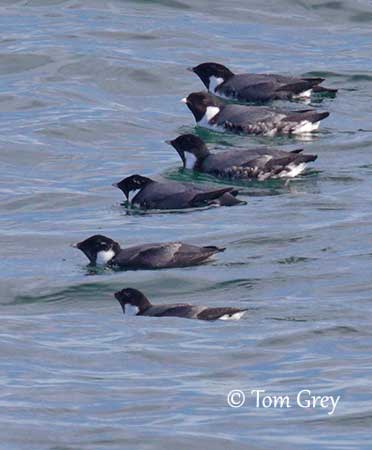
HABITAT:
The Ancient Murrelet nests in burrows excavated among tree roots into mossy ground, below tall trees in forest, often within mature coniferous stands. It may also nest in rock crevices and in well-vegetated areas even with little or no tree canopy cover.
It forages in open ocean and occasionally in fjords and inlets. It frequents primarily marine, coastal foreshore and coastal upland habitats. The Ancient Murrelet winters well offshore, usually off the shell break, but it can be seen inshore in areas with strong tidal upwellings.
CALLS AND SONGS: SOUNDS BY XENO-CANTO
The Ancient Murrelet utters a low piping whistle, and series of metallic chucking notes. The male sings at night at colonies, giving a simple song including repeated chirps.
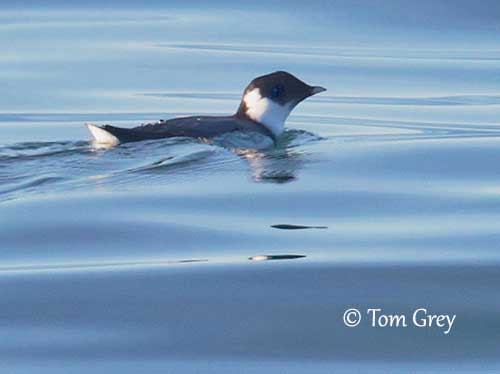
BEHAVIOUR IN THE WILD:
The Ancient Murrelet feeds on a variety of marine species including krill (Euphausia), fish such as Pacific Sand Lance, Shiner Perch and Herring, and groundfish such as Greenling found on the bottom.
But the diet varies depending on season and prey availability. Fledged and juvenile birds feed mainly on Pacific Sand Lance (Ammodytes hexapterus).
The Ancient Murrelet dives to depths of 10-20 metres, often in areas where upwellings drive the preys to the surface, and over submerged rock shelves. While underwater, it propels itself with its short wings, using them as flippers.
The Ancient Murrelet has unusual breeding behaviour. The male sings at night at nesting colonies, usually perched on tree branches or any other high perch. The song is a series of repeated chirps.
They breed in colonies, often with other Alcidae. They are probably monogamous, with high mate and site fidelity.
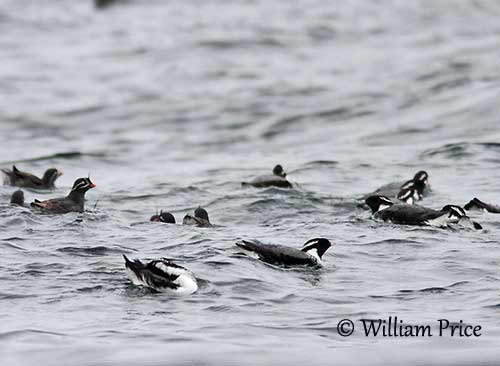
On the left
The Ancient Murrelet remains within its breeding range with only limited dispersal except in Sea of Okhotsk due to winter ice. It returns to the nesting sites at least a month before the laying. The birds perform southwards movements in October in W and E Pacific. They reach S California in late October, and Japan and Korea where numerous birds occur, between December and March. The birds breeding in British Columbia perform the return migration in February/March in less than a month, usually 28 days to cover 7600 km from Japan and China.
The Ancient Murrelet is more agile in flight than most auks, and is able to take off directly from water. While flying in flocks, the often turn in unison. The flight is swift and direct.
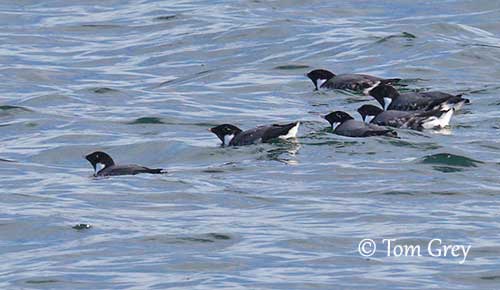
REPRODUCTION OF THIS SPECIES:
The breeding season varies depending on the range, between mid-April/early May and first half of June in British Columbia, SE Alaska and Aleutians. It starts in mid-March in China, to late June/early July in Sea of Okhotsk and Kamchatka.
The Ancient Murrelet nests in colonies often with other Alcids. It has nocturnal habits. They nest in burrows excavated under trees or grass. It is often placed on slope near the sea. Both mates dig the burrow which is about 60-150 centimetres, generally less than 2 metres long. The nest chamber is at the end of the burrow, usually lined with grass, leaves and twigs. However, the Ancient Murrelet may also nest in rock crevices or natural cavities, or it uses abandoned burrows dug by other animals.
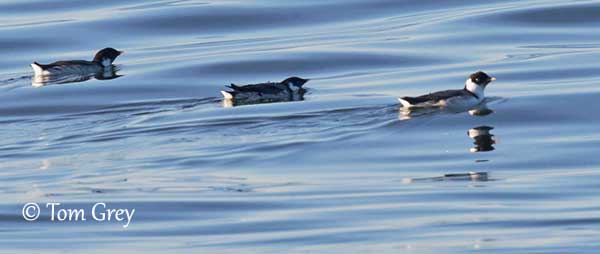
The female lays 2 pale buff or olive eggs with brown spots. Both adults incubate during 32-33 days in shifts of 3 days. At hatching, the chicks have bluish-grey down above, white below and the head is black. They are precocial and remain unfed in the burrow for 1-4 days. They leave the nest at night, when the adults call them at the entrance. They reach the sea in family group and swim away immediately. They may travel 40-50 km within 12-20 hours. The chicks are fed and reared by both parents at least during 4-5 weeks, until they are fully grown. The breeding success is usually high.
PROTECTION / THREATS / STATUS:
The Ancient Murrelet adult is preyed upon by Bald Eagle, Peregrine Falcon and Common Raven, but introduced rats and racoons are the main predators. High tanker traffic, human disturbance, oil pollution and attraction to lights of boats make this species vulnerable.
The global population is estimated to number 1,000,000/2,000,000 individuals, and this population is declining, mainly due to predation by introduced mammals.
But currently, the Ancient Murrelet is evaluated as Least Concern.
